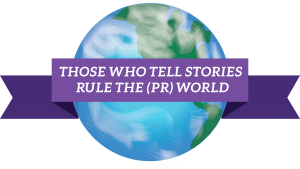
The PR landscape is rapidly shifting as consumers become product reviewers and brands become publishers. As technology and the prolific use of social media has made it easier than ever for brands to connect directly with consumers, some have questioned the need for public relations and some have even dared question the value of traditional media in the compressed news cycle.
Despite the fact that the communications path from brand to consumer looks drastically different than it did 5 years ago, I’d argue that more than ever, brands need public relations to craft, tailor and distribute their messages across all media channels.
For brands, being able to convey their story in a way that solves a problem, informs and entertains its audience is increasingly important. Stories give customers a reason to invest emotionally in a brand that goes beyond the aesthetic or mere functionality of its products. A brand’s stories merge the people at the heart of the company with the how and why that went into the finished product.
Brands can tap into their communications and PR teams to craft and distribute these stories on their behalf as part of an integrated communications strategy that feeds the purchase funnel. In fact, public relations pros are often the people best equipped to craft such stories, since they already intimately know the audience and how the customers talk about and where they connect with the brand.
This approach, which can been called “PR direct to consumers,” delivers stories unfiltered by the media that align the brand’s relevant expertise, understanding or experience in a certain area with the needs and interests of its audience. Known as “the sweet spot,” this intersection at which the audience learns something new or is entertained by the story, helps the brand gains relevancy and authenticity.
Five Keys to Successful Storytelling
1. Choose a specific topic. Rather than cram too many ideas or topics into one story, take each key message and map out two or three different angles around each message. If you end up with a dozen different story ideas, narrow the list to the best ones to craft into stories.
2. Consider your audience. Take into account where the story will be posted and who will read it, are you speaking to tech heads? Parents? Sports fanatics? Millennials? Can you use specific jargon or terminology that will resonate with these readers? Be especially cautions when using slag; any mistakes there can draw ridicule.
3. Consider the platform through which the story will be shared. A blog post should be concise and include subheads, a bullet list or step-by-step solution. In many instances blog posts are 500 words or less. However, if placing the story on the Huffington Post, for example, a more long-form essay is acceptable. If sharing the story on social media, can the story’s essence be summed up in less than 140 characters or a short Facebook post?
4. Just as the most critical part of any press release is a strong lede, story-based content must also immediately grab the reader’s attention right from the first sentence. What will he learn or gain from giving this story his attention? Give him a reason to keep reading beyond the first paragraph.
5. Avoid the sales pitch. Keep any and all marketing speak out of the story and save the call-to-action or sales pitch for your other communications pieces. Nothing spoils a flow of a good yarn than entertaining narrative that lurches into sales copy that reads like it came from a catalogue or e-comm website.
Examples:
Black Diamond CEO Peter Metcalf in “Driven”
